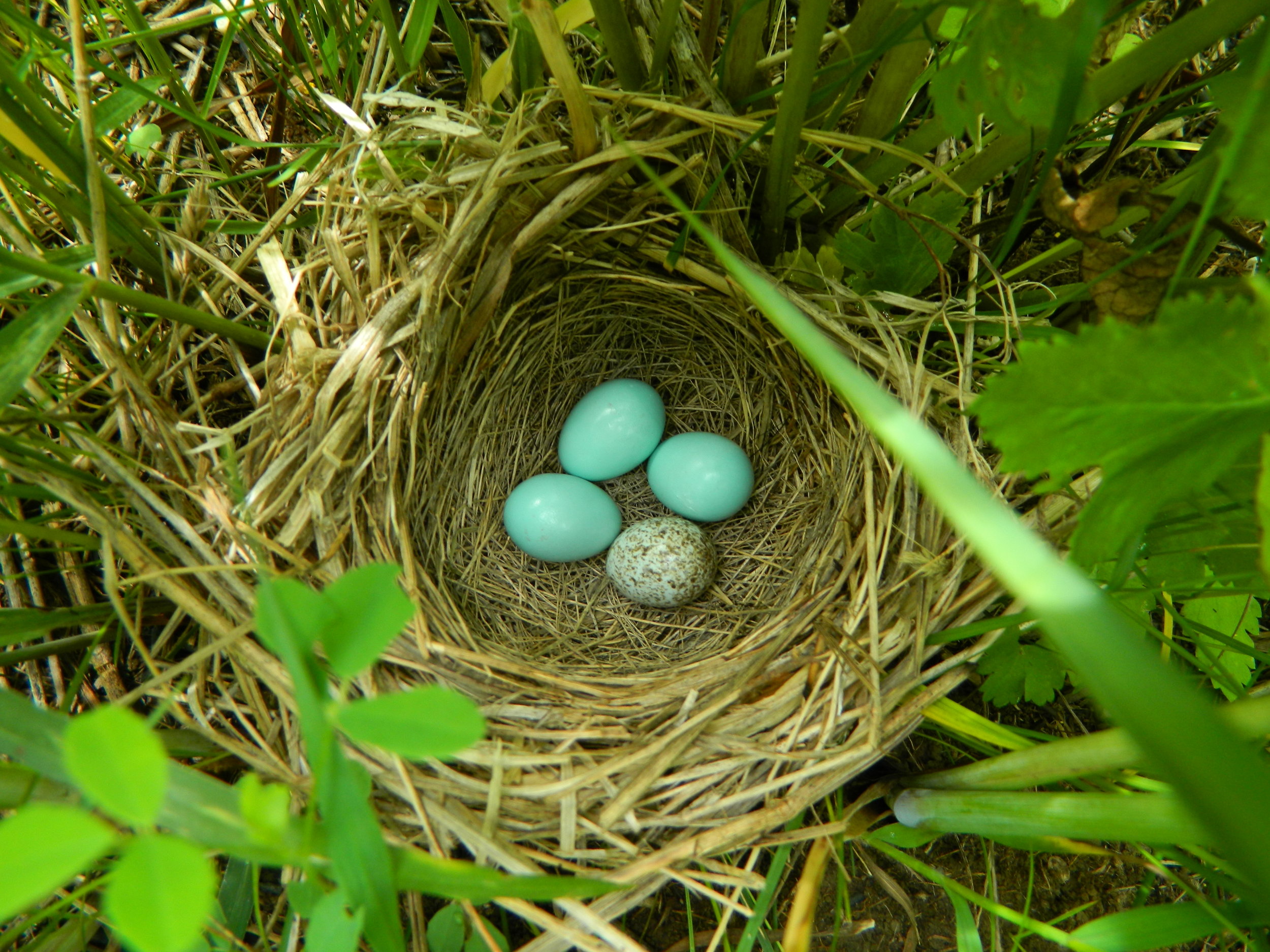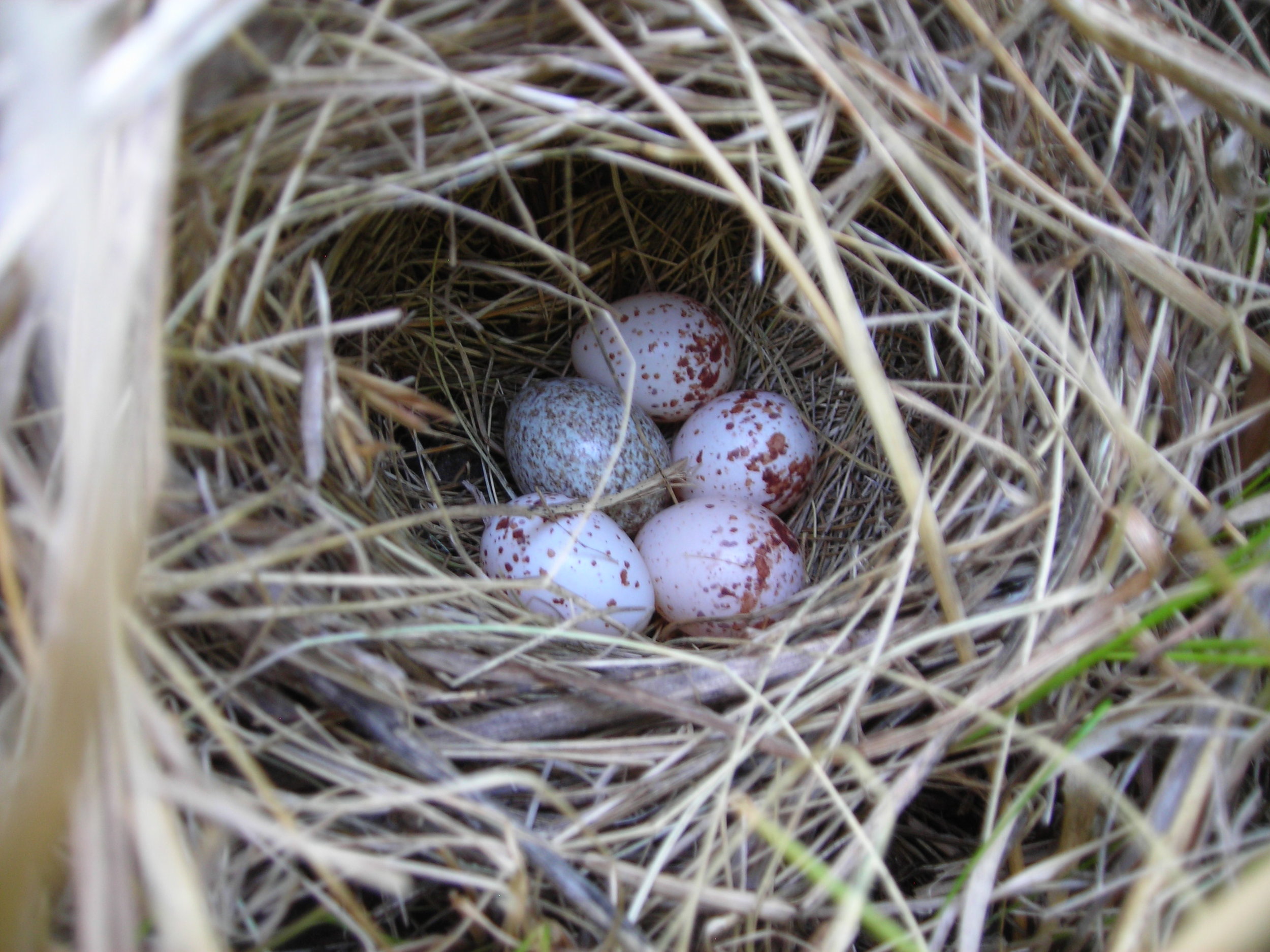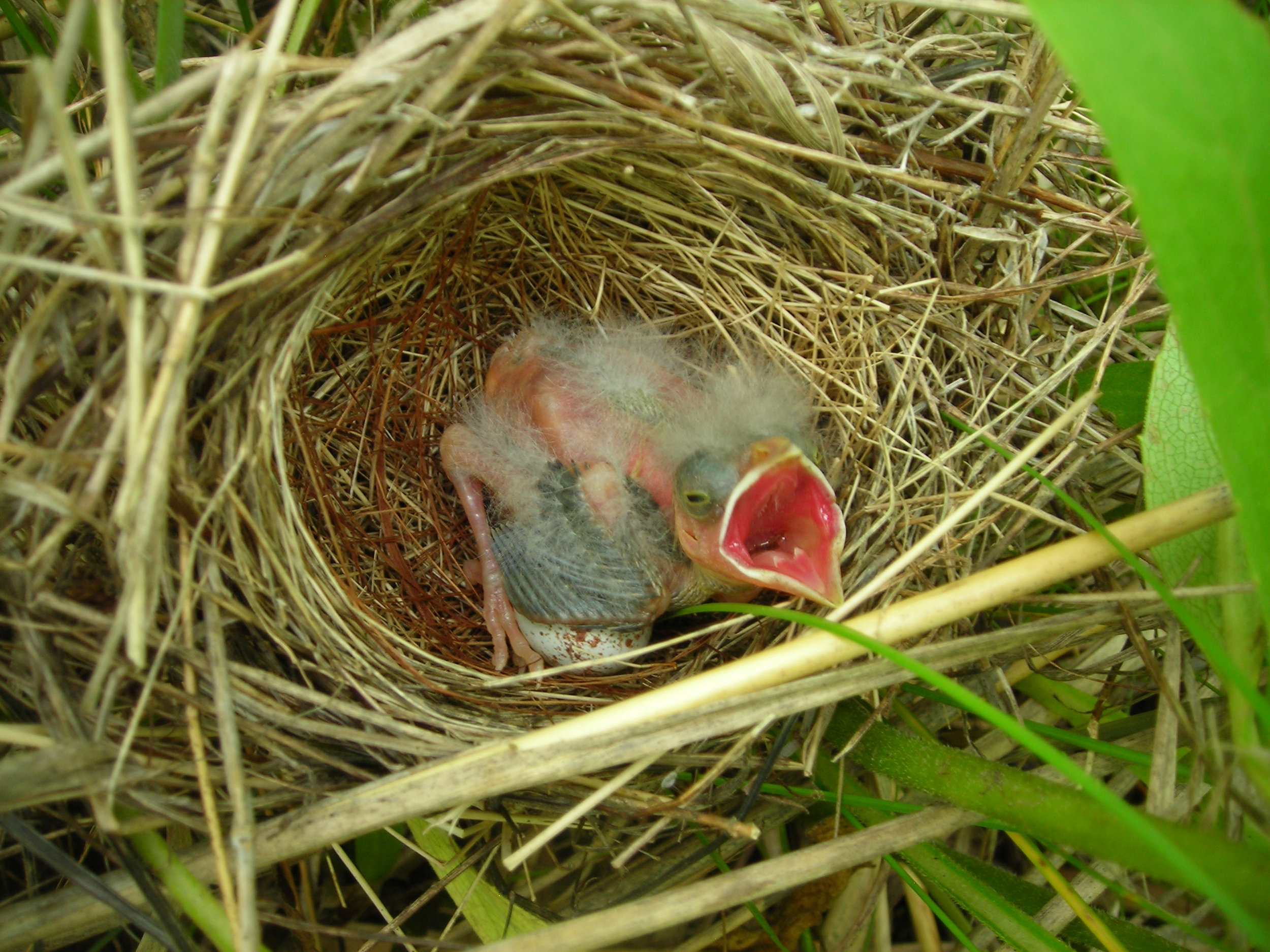This series highlights the fascinating and marvelous ecology of grassland bird nesting, written by Madison Audubon education director Carolyn Byers. Click here for all of the Into the Nest posts.
“Cowbird, the uninvited guest, leaves her egg in a foster nest.”
A lot of people really dislike - even hate - cowbirds. I get it. It can be hard to watch a small warbler trying to keep a huge cowbird chick fed, and it’s sad when host species eggs get destroyed. But objectively and unemotionally, cowbirds are amazing, smart, resilient, and cool. Their reproductive strategy allows them to produce many more offspring than the average bird. Hopefully by the end of this post, you’ll be thinking about cowbird behavior in a new light too.
Photo by JanetandPhil, Flickr CC
Photo by Glenn_E_Wilson, Flickr CC
Cowbird male (left) and female (right) are often found in mixed flocks with other blackbirds.
Cowbirds are obligate brood parasites, meaning that they never build their own nest. Instead, they lay their eggs in the nests of host species, and let those parents raise their chicks. Cowbirds are nest generalists, and have been found to lay eggs in the nests of 247 different species of birds!
Cowbirds lay their eggs in the nests of many Wisconsin birds. Here we have dickcissel, common yellowthroat, and grasshopper sparrow nests all with one added cowbird egg. Photos by Carolyn Byers
How does a cowbird egg end up in a nest?
Female cowbirds search for nests to slip their eggs into. Then they must watch nests carefully, and time their mating & egg laying perfectly-- all so the host species parents will be more likely to accept their egg. They often remove a host species egg while at the nest, so the number of eggs remains the same. Cowbirds can lay about 40 eggs during a nesting season, though the record is 70. They also lay eggs 10 times faster than most birds, allowing them to get in and out of a host nest before the parents return.
A cowbird lays an egg in a cardinal nest. The cowbird also removes one cardinal egg, and possibly damages the remaining egg- all so that her chick will have a better chance of survival.
These host birds are not entirely defenseless either, and some species smarter to the cowbird's tricks than others. Many of the birds that evolved alongside cowbirds are able to recognize when a new egg has been added to their nest and take action. American robins will eject cowbird eggs from their nest. Yellow warblers abandon their nest, or build a new nest on top of the old one (the cowbird egg doesn’t get incubated, and maybe the adult cowbirds won’t notice what happened!). Other species may not notice a larger, differently colored or shaped egg or chick, even if to human observers it should be obvious. The situation isn’t ideal for host birds, but they have all found a balance that allows each species to thrive.
One of these things is not like the other! This robin recognizes the cowbird egg in her nest and removes it. Video credit: Analía V. López, Miri Dainson Mark E. Hauber
Cowbird eggs hatch quickly, while most host species take a bit longer. There has even been research on how developing eggs in the same nest are affected by each other. Cowbird eggs may delay development of host eggs, or cowbirds may speed their development because of cues they receive from host eggs (read the full study here!) This means that the cowbird chick generally hatches first, and gets a head start. Cowbirds chicks also grow fast and strong. If you’ve read our post about keeping chicks fed (Open Wide!) you know that the chick that begs most enthusiastically gets fed first. Cowbird chicks gape so effectively that they often leave their foster siblings hungry.
Cowbird chicks are ready to leave the nest in just 10-12 days, while most of their host species take 10-14 days to fledge. This, combined with their speedier hatch time, means that cowbirds fledge faster than their foster sibs. The host parents will try to feed both the chicks in the nest and those that have fledged, but they tend to give preference to the ones who are already out in the world. Another win for the cowbird chick.
This cowbird chick has just left the nest, and was still working on its flight skills. Photo by Carolyn Byers
This adult white-crowned sparrow (right) looks tiny next to its cowbird foster child! Photo by Dawn Beattie
Cowbirds are good parents too!
Just because they don’t build their own nests or feed their chicks, doesn’t mean that they aren’t invested parents. We’ve already talked about how cowbirds carefully stake out nests to time their egg laying.
Once the egg is laid, they monitor the nest closely. If the host species removes or rejects their egg, cowbird parents strike! Scientists are calling this the “cowbird mafia”, and it’s exactly what it sounds like. Cowbird parents will destroy host eggs or chicks if their egg is rejected. This causes the host parents to renest- giving the cowbird another chance to slip an egg in. This also makes accepting their egg a better option for host parents. Usually host parents are able to raise some of their own young in addition to the cowbird chick, which is better than losing their entire nest.
This female cowbird is “farming” a nest. She destroys the host species’ chicks so that they will renest- hopefully giving her another chance to lay an egg. This is similar to the mafia behavior, except that she has not laid an egg in this nest yet. Nest cam video part of Carolyn’s research
Read more about this cool behavior in Science and from the University of Florida.
Watch Neil deGrasse Tyson explain all about the cowbird mafia in this episode of NOVA. Skip to 18:28 for the cowbird segment.
So, are cowbirds good or bad for our birds?
First of all, cowbirds are a native to the US - they belong here and are a natural part of the ecosystem! Historically, cowbirds hung around with America’s original cow, the bison. They toured around the prairies, eating the insects that bison herds kicked up. Since they were constantly moving with the herds, they didn’t impact one population of host birds for too long. After one season, they would have moved on to somewhere new.
Cowbirds with their old buddy, bison. Photo from reference.com
Brown-headed cowbirds were historically found in the shortgrass prairie in the Central Plains. They didn’t start expanding their range until people began making changes to the landscape.
For species that are already facing pressures from habitat loss, introducing cowbird parasitism really impacts populations. Removing cowbirds from areas with sensitive species (Kirtland’s warblers, for example) is only a temporary band-aid for the problem. We really need to address their underlying need for breeding habitat.
This summer, keep an eye out for cowbird behavior in your neighborhood, and try to figure out just what’s going on. Photo by putneypics
This summer when you’re out birding or walking your neighborhood, take a closer look at all of the bird interactions going on around you. Are there any cowbirds staking out a new nest? Any chicks towering over the adults that are feeding them?
And if you’re interested in learning even more about the cool cowbird, check out this Audubon article: How does a cowbird learn to be a cowbird? They have to learn the cowbird song, recognize potential mates, and learn cowbird behaviors -- all while living among birds of a different species.
So. Cool.
* * * * * * * * * * * * * * * * * * * * * * * *
Dickcissels are a beautiful, migratory grassland bird that benefits from the Migratory Bird Treaty Act. Photo by Kelly Colgan Azar
This summer, to celebrate Year of the Bird and 100 years of bird conservation under the Migratory Bird Treaty Act, we’ll be posting regular articles about grassland bird nesting ecology. My M.S. thesis focused on grassland bird nesting ecology, and I’m excited to share my knowledge—and stories from the field- with you! We’ll go into the nest to learn about chick behavior, adult sleep habits, feeding and fledging. We’ll discuss predation and learn about how adult birds respond to different predators. You’ll get to see beautiful photos of nests, eggs, and chicks, as well as video footage straight from the nest! Best of all, the next time you’re out hiking in your favorite Wisconsin prairie, you’ll feel a bit closer to the birds you love.
If you’re interested in reading more and can’t wait for the next post, you can read more about my thesis work here.
Stay tuned for our next edition of Into the Nest, coming soon!
Written by Carolyn Byers, Madison Audubon education director
Video credit:
Nest footage was generously provided by the U.S. Geological Survey, Wisconsin Cooperative Wildlife Research Unit, Madison, WI. Check out their website to learn more!
















